The size of the longest shared DNA segment can give you valuable clues about how you are connected to your DNA matches. In this post, I'll explain the concept by showing you how DNA segments get smaller over four generations.
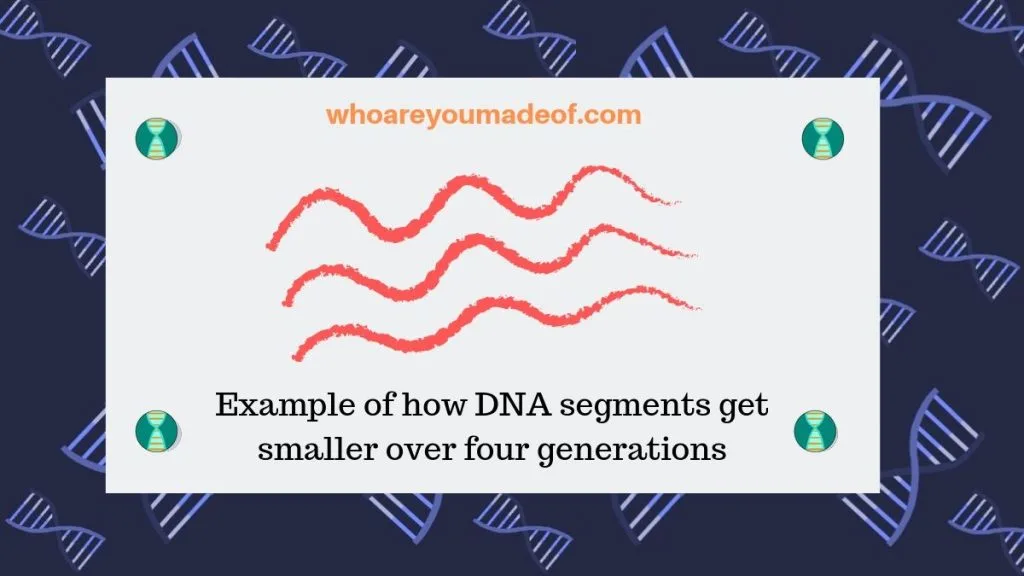
When you are trying to figure out how a DNA match is related to you, you know that you have to use every available detail to find out how far back you need to look for your common ancestor.
How long are DNA segments shared between parent and child?
One of the first questions that you might have about DNA segments is "how long can a DNA segment be"? To answer this question, we need to look at shared DNA between a parent and a child, since this is where we will find the longest DNA segments.
When a child inherits DNA from their parents, they inherit it in very long segments, since they get large portions of each chromosome from each parent. Every chromosome has a different "length", or size.
For example, Chromosome 1 is the largest human chromosome, and parents should share a segment of about 281 cMs on this chromosome. This should be the largest DNA segment that you see, if you are able to compare your DNA with that of either of your parents.
For this post, I wanted to show you an example of how one DNA segment is broken up over the course of four generations. We'll use a shared DNA segment on Chromosome 5.
The image below shows a DNA segment shared between my dad and his mom. You can see that they share a whopping 209.3 cMs on this chromosome.
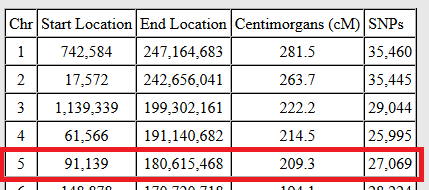
How long are DNA segments between grandparent and grandchild?
The size of DNA segments shared between parents and children is fairly predictable, since children inherit large portions of a segment directly from each immediate ancestor (their parents) and the percentage shared between child and parent is just about exactly 50%.
DNA shared between grandparents and grandchildren can vary quite a bit more, and to understand this, we'll use an example.
The length of DNA segments that you see in this example will not exactly match the DNA that you share with your grandparents. While your parent inherited exactly 50% of their DNA from each of their parents, you might share a little more or a little less than 25% with either of your grandparents.
This also means that there is a variation in length and number of DNA segments that you will share with your grandparents. The only thing that you can count on is that most of your shared segments will be fairly long, but the exact length will vary.
Do you remember that DNA segment on Chromosome 5 that my dad shares with his mom (my grandmother)? In the image below, you can see that the shared segment has gotten much smaller.
While I still share a long segment on Chromosome 5 with my dad, only part of it matches with my grandmother. This means that the rest of my shared segment with my dad on this chromosome must match my grandfather.
One other interesting thing that you might notice in the image below is that the DNA segment that my dad inherited from his mom on Chromosome 2 (which was 263 cMs between my dad and my grandmother) has now gotten smaller and more broken up. On Chromosome 2, I share two segments with my grandmother. One is small, and one is still pretty big.
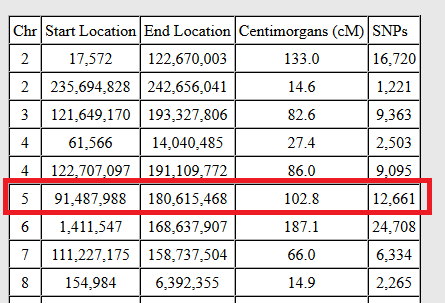
How long are DNA segments between great-grandparent and great-grandchild?
By the time we get to a great-grandchild, we begin to notice that DNA segments are becoming significantly smaller. If you look at the image below showing shared DNA between my daughter and my grandmother (her great-grandmother), you can see that she only inherited 65.8 cMs out of the 102.8 cMs that matched my grandmother on Chromosome 5.
Another interesting detail are the segments from Chromosome 2. She inherited the 14.6 cM segment completely intact from me, but got less than half of the larger segment on that chromosome.
This is interesting, since it demonstrates the "randomness" of DNA inheritance. There is nothing special about the 14.6 cM segment. When she was conceived, she just happened to get that entire segment, and only a portion of the other segment.
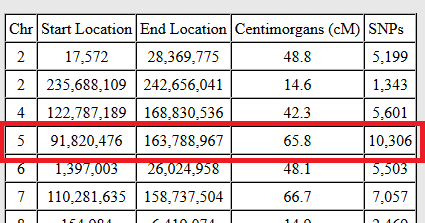
What about DNA segments shared between cousins?
Now that you see how a segment can get smaller and broken up after only a few generations, you can imagine that the same thing is also happening on the other lines of the family. If we use my grandmother as an example, we can imagine that her siblings are also passing down DNA segments to their children, and the shared DNA segments are also getting smaller as each new generation is conceived.
There is one important bit of information that you'll need to know, however: Siblings don't share 100% of the same DNA. In fact, they only share about 33-50% identical DNA.
On our now-famous Chromosome 5, you can see in the image below that my grandmother and her brother share three segments on that chromosome:

As my great-uncle's (my grandmother's brother) DNA segments get passed down through his children to their children, the same thing will happen as you saw happening with my grandmother's segments. They will get smaller, and become broken up.
The effect of the way that segments are passed down is that the descendants of my grandmother and her brother will share a smaller number of DNA segments, and segments that they do share will be smaller.
For example, take a look at the shared DNA on chromosome 5 between my great-uncle's brother's son and my daughter (they are first cousins twice-removed):
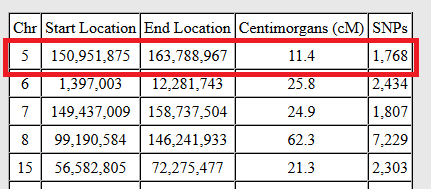
You can see that my daughter and her first cousin twice-removed still share a few sizeable DNA segments on some other chromosomes, but those segments will be broken up, too, for future generations.
For example, there is a good chance that my daughter will not share any identical DNA on chromosome 5 with the children of her first cousin twice-removed (second cousins once-removed), though she will still share smaller segments on some of those other chromosomes you see in the image above.
How does knowledge about length of DNA segments help you know how a DNA match is related?
As you might have noticed, people with closer relationships tend to share longer DNA segments. As relationships grow more distant, the size of segments gets smaller.
This means that if you have a DNA match where you have several shared segments, all longer than 25-50 cMs, you are looking at a relatively close cousin. If you only share one segment that is 25 cMs in length, there is a probability that they are a third cousin or more distant.
In order to know exactly how two people are related, you will need to use more traditional family tree research, but shared DNA (and length of segments) is a good way to know how far back you need to look in your tree to find your most recent common ancestor.
Note: Apart from a parent/child relationship, there is no direct correlation between the exact length of a segment and the genealogical relationship between two people (with the x chromosome as the exception - topic for another day).
Conclusion
I hope that this post gave you some insight as to the effect of DNA segments being broken up over time, and how to use this information to figure out how you might be related. If you have any questions about something that you read here, or would like to share what you have seen in shared DNA segments between two relatives, I would love to hear from you in the comments below.
Thanks for stopping by today!

